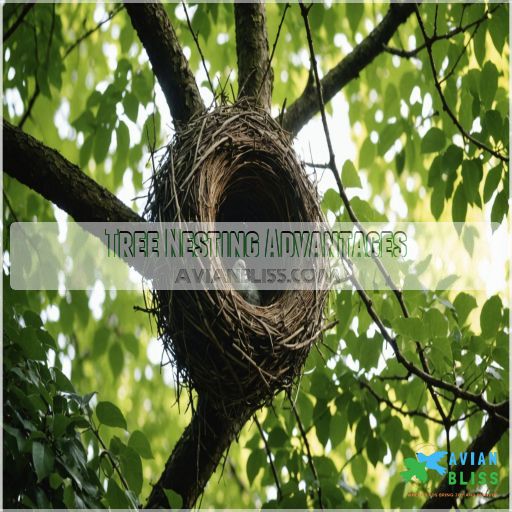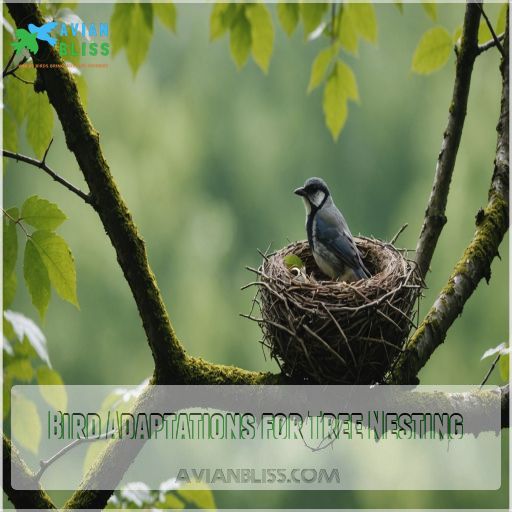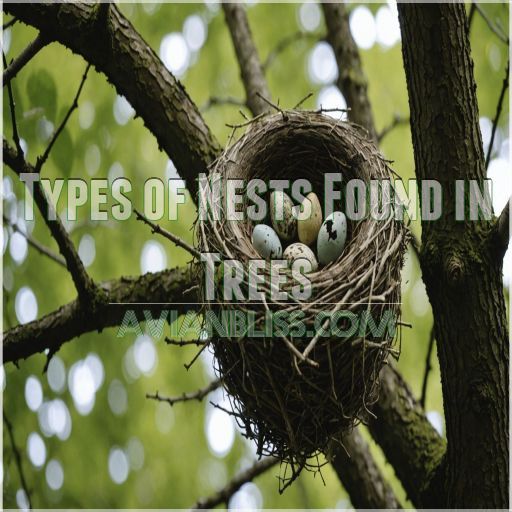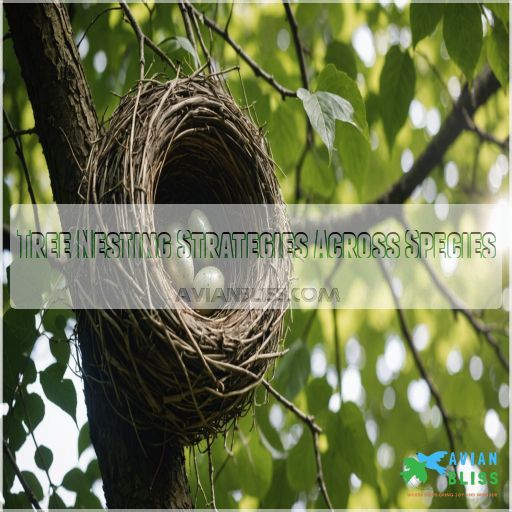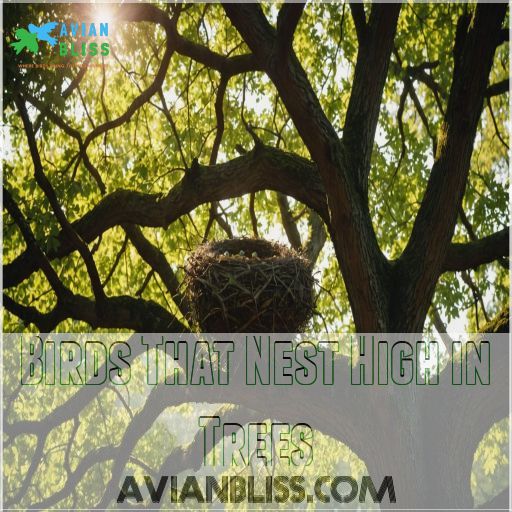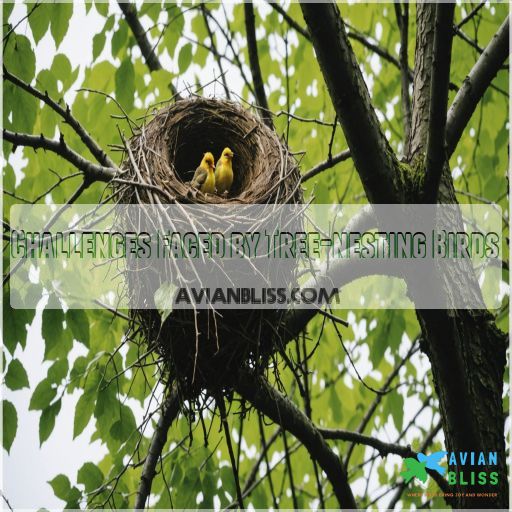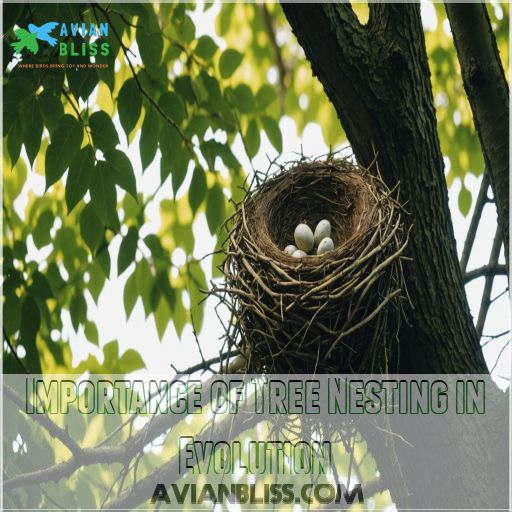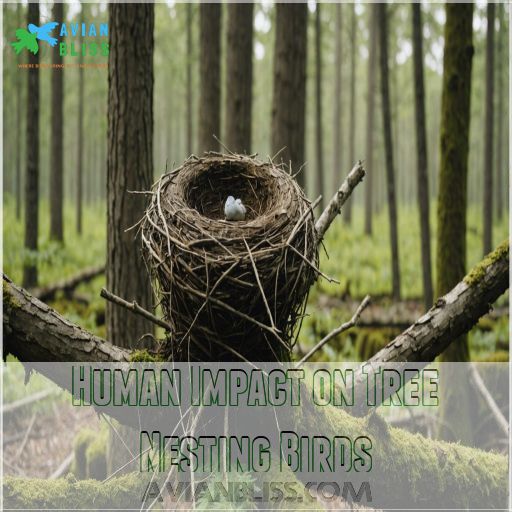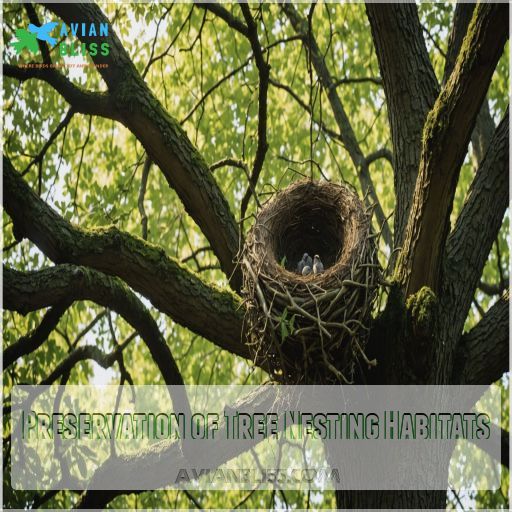This site is supported by our readers. We may earn a commission, at no cost to you, if you purchase through links.
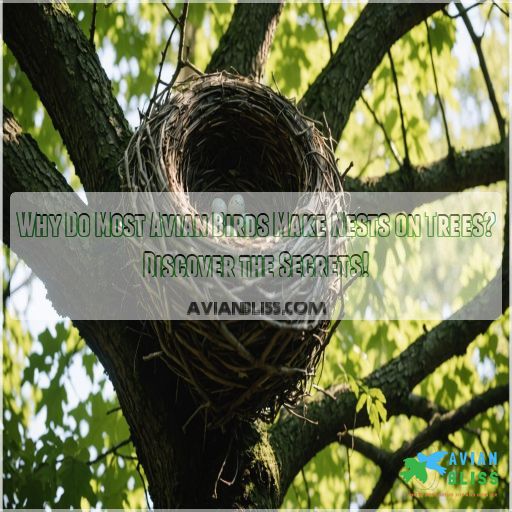
You’ll find that tree nests provide excellent shelter from harsh weather and create the perfect microclimate for egg incubation. Plus, it’s like nature’s camouflage – blending in with the foliage keeps those eggs out of sight from hungry predators.
Birds have evolved some nifty adaptations for tree living, too. From specialized feet for gripping branches to beaks designed for weaving intricate nests, they’re true masters of arboreal architecture. But there’s more to this high-rise living than meets the eye – they’ve also developed nature’s camouflage.
Table Of Contents
- Key Takeaways
- Tree Nesting Advantages
- Choosing the Right Tree
- Bird Adaptations for Tree Nesting
- Types of Nests Found in Trees
- Tree Nesting Strategies Across Species
- Birds That Nest High in Trees
- Challenges Faced by Tree-nesting Birds
- Importance of Tree Nesting in Evolution
- Human Impact on Tree Nesting Birds
- Preservation of Tree Nesting Habitats
- Frequently Asked Questions (FAQs)
- Why do birds build nests on trees?
- How do birds construct their nests?
- Why do birds build nests in ponds?
- Why do birds have different nesting habits?
- What birds nest high in trees?
- Why do birds sit on top of trees?
- What does a bird nest on a tree mean?
- Why do birds build nests in trees?
- How do birds construct nests in trees?
- What materials do birds use for tree nests?
- Do different bird species share nesting trees?
- How do tree-nesting birds protect eggs from predators?
- Can birds reuse or modify existing tree nests?
- Conclusion
Key Takeaways
- You’ll find that trees offer birds a high-rise haven, keeping their precious eggs and chicks safe from ground predators. It’s like nature’s version of a penthouse suite – lofty, exclusive, and with killer views to spot any approaching threats.
- Trees provide birds with their own personal weather station. The leafy canopy acts as an umbrella, shielding nests from harsh elements while creating a cozy microclimate that’s just right for incubating eggs. Talk about five-star accommodations!
- By nesting in trees, birds become masters of disguise. The foliage provides excellent camouflage, making nests blend in like chameleons at a leaf convention. It’s nature’s way of playing hide-and-seek with predators.
- Tree nesting isn’t just a random choice – it’s the result of millions of years of evolutionary fine-tuning. Birds have developed specialized feet for gripping branches and beaks for weaving intricate nests. They’re like tiny, feathered architects with an impressive toolkit for treetop living.
Tree Nesting Advantages
Ever wondered why birds prefer setting up homes in treetops?
It’s all about keeping their chicks safe from ground predators.
Having a high perch to spot threats is also a significant advantage.
Those leafy branches offer excellent weather protection and cozy microclimates.
Protection From Ground Predators
While birds sing their way up to treetops, they’re actually using savvy nest site selection to dodge ground predators. Picture a secret fort in the treetops.
- Distance from ground predators like snakes.
- Height advantage against four-legged foes.
- Natural defense strategies in tree branches.
- Reduced nest predation by being off the menu.
Stay safe and comfy up there!
Improved Visibility for Detecting Threats
Perched high in trees, bird nests offer a natural "watchtower" for spotting danger. With heightened visibility, birds can see predators approaching from afar, offering time to evade. It’s like having a front-row seat at a wildlife cinema, but with life-or-death stakes!
The strategic height also enhances camouflage, blending nests seamlessly into the leafy backdrop.
| Feature | Benefit |
|---|---|
| Height Advantage | Early Detection |
| Bird Vision | Enhanced Awareness |
| Nest Location | Safety First |
| Camouflage | Stealthy Shelter |
Shelter From Harsh Weather Conditions
Imagine a cozy home above ground, safe from harsh weather—birds find trees perfect for this.
Tree nesting offers several benefits, including:
- Rain protection: Thick canopies shield from heavy downpours.
- Wind resistance: Branches sway but rarely break.
- Temperature control: Leaves provide shade in summer, warmth in winter.
- Weather-related nest adaptations: Nest construction is robust against climate change impacts, enhancing survival.
Suitable Microclimates for Egg Incubation
You know, tree nests offer birds a comfy spot with just the right conditions for egg incubation. Factors like egg temperature regulation and humidity control matter. It’s akin to choosing a well-insulated house over a drafty shack. These nests smartly use nesting materials and tree characteristics to create suitable microclimates, ensuring the eggs thrive amid nature’s unpredictability.
| Factor | Benefit | Impact |
|---|---|---|
| Egg Temperature | Regulation | Stable development |
| Nest Insulation | Keeps warmth | Encourages hatching success |
| Humidity Control | Balances moisture | Protects eggs from drying |
| Microclimate Variations | Natural adjustment | Adapts to environmental shifts |
| Nesting Material Impact | Defense mechanism | Shields from external factors |
For instance, consider nest insulation like a cozy sweater that retains warmth, allowing embryos to grow steadily. Meanwhile, humidity control is akin to maintaining just the right moisture level, helping prevent eggs from drying out or getting too damp. These nests, nestled in trees, are nature’s way of providing protection and favorable conditions for the next generation.
Better Camouflage Than Ground Nesting
Nesting high in the trees provides birds with a distinct advantage – better camouflage than ground-dwelling nests.
By blending into the foliage, tree-dwelling birds can:
- Conceal their nests from predators
- Leverage their natural coloration to match the surrounding environment
- Disrupt the outline of their eggs for added stealth
- Avoid detection by visually-oriented predators
This camouflage is a key evolutionary adaptation that enhances the survival chances of tree-nesting birds.
Better Temperature Regulation Than Ground Nesting
Birds take advantage of tree nests for better temperature regulation. High off the ground, these nests enjoy improved airflow and shade benefits that help dissipate heat and create a stable microclimate.
This natural insulation is essential for species like weaver birds and bald eagles, protecting against temperature extremes and invasive species, utilizing water-resistant down feathers with special oil glands
.
While ensuring the comfort and safety of their eggs, these nests provide a vital function for the survival of various bird species, highlighting the importance of natural insulation.
Better Hygiene Than Ground Nesting
Building nests in trees is a bird’s secret sauce for keeping things spotless.
Elevated perches help avoid diseases by reducing exposure to ground parasites.
Birds benefit from:
- Disease Prevention: Less contact with ground pathogens.
- Parasite Avoidance: Fewer creepy crawlers.
- Cleanliness Benefits: Airy homes promote freshness.
- Sanitation Impact: Higher nests, happier birds.
Tree nests are nature’s cleaning crew!
Choosing the Right Tree
When you’re picking the perfect tree for your avian abode, strong branches, thick leaves, and natural hideaways are your best friends.
Remember, tall trees offer more than just a bird’s-eye view—they’re like the penthouse suite of the forest, complete with room service in the form of nearby water sources!
Branch Structure and Stability
When considering where to build a nest, starting with a solid foundation is key.
Strong branches on older trees offer the strength and flexibility necessary for handling the weight of a nest and resisting wind. It’s like finding the perfect spot in the park for a picnic—comfortable and safe!
Plus, tree age enhances branch resilience for the best possible outcome.
Foliage Density and Concealment
Finding the perfect tree involves more than just sturdy branches.
Dense foliage is like the ultimate camouflage, shielding avian homes from prying eyes.
Predators are left scratching their heads as nests blend right in, nature’s own hide-and-seek.
Visual cues vanish, and these leafy sanctuaries offer peace of mind.
It’s like having an invisibility cloak—Harry would be jealous!
Tree Height and Location
Choosing tree height and location for a nest is like selecting the perfect apartment.
Birds need security, so they often pick lofty spots to dodge ground predators and make sure they’ve a panoramic view for spotting threats.
Plus, these treetop havens are often rich in food sources, making them prime real estate for avian families seeking the ultimate habitat suitability , and providing them with a panoramic view.
Presence of Natural Cavities or Hollows
As you look for the perfect tree, those natural cavities and hollows become a bird’s version of a comfy condo.
They’re not just any old nooks; they’re prime spots for cavity nesting, offering snug protection.
Woodpeckers are nature’s carpenters, often starting the trend.
These hollows offer safety, warmth, and an ideal microclimate for successful nesting (Source).
Proximity to Water Sources
Natural cavities offer snug nooks, but proximity to water sources adds a splash of life. Birds know water access quenches thirst but also attracts insects—handy dining!
Imagine constructing your cozy nest amidst prime real estate: a leafy abode with drinking water, food sources, and nesting materials right there. Plus, cleaner nests mean happier chicks!
Bird Adaptations for Tree Nesting
Ever wondered why birds are such experts at building nests high up in trees?
It’s all thanks to their nifty adaptations — from their specialized feet for gripping branches to using their beaks like tiny architects gathering materials.
Some birds even have camouflage plumage to match the foliage.
Specialized Feet for Gripping Branches
Picture a bird relaxing on a branch. Its feet are evolution’s masterpiece, perfectly engineered to grip branches. With a zygodactyl or anisodactyl arrangement, they secure their nests against gusts.
- Evolution of Bird Feet: Nature’s climbing shoes.
- Foot Anatomy: Built for balance.
- Branch Grip Strength: Vice-like hold.
- Tarsal Bone Structure: Adapted for twist and turn.
Beak Shapes for Gathering Nesting Materials
Just as you wouldn’t grip branches without specialized feet, birds don’t gather nesting materials without the right beak shape.
Their beaks, a marvel of evolutionary adaptation, help in selecting and handling materials like twigs or delicate fibers.
From the hummingbird’s needle-like beak to the eagle’s powerful one, each species showcases unique variations perfectly suited for their nesting behavior .
Camouflage Plumage for Blending With Foliage
Ever wonder why birds seem to vanish amidst leaves?
It’s all about camouflage plumage for blending in with foliage.
Birds like the Western Screech-Owl boast mottled patterns that hide them from predators’ watchful eyes.
This clever evolutionary adaptation helps both safety and freedom, letting birds carry on their chirpy lives without becoming someone else’s lunch!
Nest-building Instincts and Behaviors
Instinctively, birds are hardwired to build nests, a cozy abode for their young.
From selecting the perfect tree branch to carefully weaving twigs and leaves, this innate behavior is a marvel to witness.
Like seasoned architects, they construct sturdy, well-insulated homes, showcasing their impressive nest-building skills honed over generations.
Vocal Communication for Territory Defense
Birds don’t just build nests; they turn their homes into fortresses with vocal flair.
Their vocal communication includes:
- Territorial songs: Like invisible fences, these tunes ward off rivals.
- Alarm signals: Shouting "Danger!" when threats lurk.
- Mating displays: Sing your heart out to woo a mate.
- Nest defense: Chirp fiercely to protect chicks.
These calls are their fortress walls.
Types of Nests Found in Trees
You’ll discover that birds create an incredible variety of nests in trees, each designed to meet its unique needs and environment.
From cozy cup nests to creative pendants, birds are the ultimate architects of the treetops, showing off their construction skills in sometimes unexpected ways—even if they don’t have a degree in engineering!
Cup Nests: Construction and Materials
Imagine a bird’s home that hugs trees—cup nests.
Their building process is like crafting your favorite chair; sturdy on the outside, soft inside.
Birds use sticks, leaves, mud, and sometimes feathers to create these cozy cradles.
Nest size varies, giving chicks a snug, safe haven.
Who knew nest-building involved such finesse and flair?
Platform Nests: Design and Placement
You’ve mastered cup nests, now let’s talk platform nests. Ospreys and raptors craft these spacious structures with twigs, perching them high for predator safety and territorial views.
It’s like a bird condo—spacious and secure. As materials pile up, they grow sturdy with age, offering stability and prime locations above would-be threats.
Cavity Nests: Natural and Excavated
Platform nests are impressive, but cavity nests offer unique benefits.
These hidden homes protect against harsh weather and predators, providing a snug, safe haven.
Woodpeckers are the architects, expertly crafting holes, while others, like owls and nuthatches, move in afterward, benefitting from nature’s handiwork .
Cavity nesters choose locations wisely, ensuring their miniature gated communities remain secure.
Pendant Nests: Hanging Construction Techniques
If you’re looking to build amazing homes, check out pendant nests—the acrobats of the avian world! Birds like Baltimore orioles and weavers craft these hanging masterpieces using nest materials like grass and spider webs.
Hanging methods offer evolutionary advantages:
- Avoid ground predators
- Structural stability
- Shelter from weather
- Specialized bird species.
Adherent Nests: Attachment Methods
Some birds take tree nesting to the next level by constructing adherent nests – those that are firmly attached to branches or tree trunks.
These clever architects use a variety of materials like mud, saliva, and even spider webs to cement their nests in place, providing unparalleled stability and protection from predators.
Tree Nesting Strategies Across Species
When you explore tree nesting strategies, you’ll find birds employing solo or communal nesting with unique adaptations to balance safety and resources.
Whether sticking to favorite spots year after year or making cooperative living arrangements, these feathered architects reveal fascinating approaches to surviving and thriving among the branches.
Solitary Nesters Vs. Colonial Nesters
After designing their nests, birds face a choice: solitude or community.
Solitary nesters enjoy privacy and defend their territory fiercely, fostering strong one-on-one bonds.
Colonial nesters, like gregarious party-goers, benefit from shared vigilance and nest defense against predators, boosting breeding success .
Each style reflects an avian social dynamic as unique as any bird’s brown bird characteristics, plumage
.
Single-brood Vs. Multiple-brood Strategies
Ever wondered why some birds go for single-brood while others embrace multiple-brood strategies?
It’s all about balancing parental care and egg survival.
Larger brood size often demands more nesting frequency, ensuring young ones’ safety but at a cost to parents.
Talk about juggling kids and chores!
Different strategies reflect diverse approaches to ensuring next generations thrive through efficient parental care .
Nest Site Fidelity and Reuse
Birds often practice nest fidelity and reuse as a savvy strategy to enhance their nesting success.
Imagine visiting your favorite vacation spot annually; these avian architects return to familiar sites, reducing the hassle of starting from scratch.
This adaptive reuse saves energy but also can boost survival rates by providing a reliable and secure environment for raising young (Source).
Interspecific Competition for Nesting Sites
Nest competition can be fierce!
Picture a bustling apartment complex with a waiting list—a bird’s condo dispute, if you will.
Nesting site scarcity forces different bird species into resource competition.
They engage in territorial defense, often leading to niche partitioning.
Adaptive strategies develop, ensuring survival while managing limited real estate.
It’s survival of the fittest in the avian world!
Cooperative Breeding in Tree-nesting Species
While competition for nesting sites is a challenge, many birds rise to the occasion with cooperative breeding in trees.
This teamwork involves:
- Nest helpers: These altruistic individuals aid in parental care, boosting breeding success.
- Kin selection: Birds assist relatives, securing shared genetic survival.
- Enhanced protection: More eyes for spotting threats make sure everyone’s safety.
Birds That Nest High in Trees
Birds that nest high in trees come in all shapes and sizes – from the majestic eagles that build elaborate stick nests to the humble sparrows that tuck their simple cup-shaped homes into natural tree cavities.
Discover the fascinating reasons why so many avian species choose to raise their young up in the treetops, just like after a successful cloacal kiss encounter
.
Species That Favor Tall Trees
From towering heights, certain bird species enjoy the perks of prime real estate in tall trees.
These lofty perches offer a panoramic view for spotting predators and plentiful food availability.
Imagine living on the penthouse floor. Eagles and ospreys relish such a lifestyle.
Their nests, high above, provide safety and visibility in a treetop haven .
Birds That Build Elaborate Nests
In the treetops, some birds are like architects on a mission, weaving elaborate nests that would make any homebuilder proud.
Species like the Southern Masked Weaver, which often choose trees as their preferred nesting sites due to abundant food sources nearby, craft stunning structures with grasses and leaves, showcasing significant nest design and bird behavior skills.
These intricate creations reflect an evolutionary purpose, blending beauty with function, much like nature’s construction miracles.
Birds That Use Natural Cavities
After exploring elaborate nests, let’s peek into nature’s hideaways: natural cavities. These sites are perfect for birds like owls and kestrels, offering a snug fit in woodpecker-dug nooks.
- Defense: Cavities offer predator protection.
- Comfort: Birds find warmth and shelter.
- Competition: They spark fierce battles for prime spots.
Birds That Build Simple Nests
Not all birds need fancy digs up high. Some feathered friends opt for a simpler approach, building basic nests that get the job done.
You’ll find these no-frills nesters crafting homes with twigs, grasses, and moss.
Take the chiffchaff and blackcap, for instance. These little guys prefer to keep things low-key, nesting in thickets of bramble where they’re safe from prying eyes and harsh weather.
Challenges Faced by Tree-nesting Birds
You might think life’s a breeze for birds nesting in trees, but they face some serious challenges.
From habitat loss to climate change, these feathered architects have to contend with a host of threats that can turn their treetop homes into precarious perches, posing a risk to their very existence due to climate change.
Habitat Loss and Deforestation
You’ve seen how some birds prefer lofty perches for their nests, often seeking shelter in concealed tree spots
. Now, let’s talk about a major threat they face: habitat loss and deforestation. It’s like someone tearing down your home!
When forests vanish, birds lose important nesting spots. Here’s what happens:
- Important nesting habitat disappears
- Food sources dwindle, disrupting the food chain
- Birds struggle to find new homes to feed and breed
Imagine being evicted from your cozy treehouse – that’s what our feathered friends are dealing with!
Climate Change Impacts on Nesting Patterns
As our planet warms, climate change is throwing a wrench in the delicate timing of bird nesting patterns. You’ll notice that many birds are laying eggs earlier than ever before – up to 6.6 days per decade on average . This shift can have profound effects on breeding success and food availability.
Let’s explore how climate change impacts different aspects of tree nesting:
| Aspect | Impact | Adaptation |
|---|---|---|
| Nesting Timing | Earlier egg-laying | Some species adjusting |
| Food Availability | Potential mismatch | Long-distance migrants at risk |
| Migration Patterns | Shifting northward | Some species struggle to adapt |
Nest Predation and Parasitism
Tree-nesting birds face constant threats from clever predators and cunning parasites. You’d be amazed at the lengths these crafty creatures go to for an easy meal or free childcare.
- Egg thieves like jays and chipmunks raiding nests
- Brood parasites (like cowbirds) laying eggs in other birds’ nests, such as those of cardinals during breeding season
- Aerial predators like hawks ambushing inexperienced fledglings are a serious threat to birds
Despite these hurdles, many birds persist, adapting their nesting strategies to outwit their adversaries. It’s a never-ending game of survival in the treetops!
Human Disturbance and Urbanization
In the midst of urban sprawl, tree-nesting birds face a unique set of challenges.
You’ll find that human disturbance and urbanization greatly impact their nesting habits.
While some species flourish in cities, exploiting novel food sources and artificial nesting sites , others struggle with reduced natural food availability and decreased vegetation cover.
Urban heat islands can benefit some birds, but anthropogenic materials in nests may lead to increased mortality.
It’s a mixed bag of urban adaptation, reflecting the complex effects of human disturbance on urban wildlife.
Competition With Invasive Species
Invasive species throw a wrench in the delicate balance of tree-nesting birds‘ lives. You’ll be surprised to learn how these unwelcome guests impact our feathered friends: Birds often nest high in trees to avoid ground predators and enjoy improved visibility, but invasive species can disrupt this tree nesting safety. This high ground advantage is essential for their survival, and invasive species can compromise this protection.
- Stealing prime nesting spots
- Reducing insect populations essential for chick-rearing
- Introducing predators like fire ants
- Spreading diseases such as West Nile virus
It’s like having noisy neighbors move in next door, but with more serious consequences. Our native birds are facing an uphill battle, and they need our help to reclaim their treetop homes.
Importance of Tree Nesting in Evolution
You’re about to uncover the fascinating role tree nesting played in shaping bird evolution.
From ancient adaptations to modern survival strategies, tree nesting has been a game-changer for our feathered friends.
Evolutionary History of Tree Nesting
You might be surprised to learn that tree nesting has deep roots in avian history.
Dating back to the early days of passerine birds, this behavior played a key role in their evolutionary success .
As global climates shifted and flowering plants expanded in the late Tertiary, small birds found a wealth of new habitats to explore, particularly those that resembled the House Sparrow’s wintering grounds
.
This diversity of options set the stage for an explosive adaptive radiation among our feathered friends.
Adaptation to Tree Nesting
Birds have truly mastered the art of tree nesting over millions of years.
You’ll find that these feathered architects have developed some nifty tricks to make their treetop homes cozy and safe. From specialized feet for gripping branches to beaks perfectly shaped for gathering twigs, they’ve got all the tools of the trade.
It’s like they’ve evolved their own little construction company in the sky!, having developed specialized feet and nifty tricks along the way.
Role of Tree Nesting in Species Survival
Tree nesting plays a key role in species survival.
It’s like having a cozy treehouse that keeps you safe from ground-based threats.
By nesting high up, birds can better protect their eggs and chicks from predators.
This strategy has helped many bird species thrive over time.
Woodpeckers, for instance, have mastered the art of creating snug homes in trees, increasing their chances of successful reproduction.
Impact of Tree Nesting on Biodiversity
Nestled among the branches, tree nesting plays a key role in shaping biodiversity. You’ll find it fosters species diversity through habitat specialization and evolutionary adaptations.
Tree nesting creates a complex ecosystem where different birds carve out unique niches, leading to:
- A colorful tapestry of nests, from cup-shaped homes to hanging pendants
- A symphony of bird calls echoing through the canopy
- A bustling aerial neighborhood teeming with life
This aerial real estate game isn’t just for the birds—it’s nature’s way of keeping things interesting!
Human Impact on Tree Nesting Birds
You might be surprised to learn how much humans affect tree-nesting birds. From deforestation to climate change, our actions have far-reaching consequences for these feathered architects and their sky-high homes.
Effects of Deforestation on Nesting Sites
Deforestation’s impact on bird nesting sites is like a wrecking ball to their homes. You’d be shocked at how quickly habitats vanish, leaving our feathered friends in a pickle.
Habitat fragmentation turns lush forests into patchy remnants, forcing birds to squeeze into smaller spaces . It’s not just about losing trees – it’s about resource depletion and population decline.
Birds face a real "musical chairs" situation, scrambling for fewer nesting spots as their world shrinks around them.
Impact of Climate Change on Nesting Patterns
Climate change is throwing our feathered friends for a loop.
You might notice birds laying eggs earlier than usual – some Chicago species are doing it nearly a month ahead of schedule.
This shift can spell trouble, as birds risk nesting during "false springs" when food isn’t yet abundant. It’s like showing up to a party before the snacks are ready, which can be a result of the birds adjusting to a new schedule.
Conservation Efforts for Tree-nesting Birds
In the face of mounting challenges, conservation efforts for tree-nesting birds are taking flight. You can play a key role in protecting these feathered architects.
- Support habitat restoration projects
- Participate in nest box programs
- Advocate for sustainable forestry practices
By championing these initiatives, you’re not just saving trees – you’re preserving entire ecosystems. Remember, every nest saved is a small victory in the grand symphony of nature conservation.
Preservation of Tree Nesting Habitats
You’ve learned why birds nest in trees, but what can we do to protect these important habitats?
Let’s explore some practical strategies for preserving tree nesting sites and the key role you can play in conservation efforts.
Conservation Strategies for Tree Nesting Sites
You can play a big role in conserving tree nesting sites for our feathered friends.
Let’s explore some effective strategies:
| Strategy | Benefit | Example |
|---|---|---|
| Nest box programs | Provides alternative homes | Installing bluebird boxes |
| Habitat restoration | Improves nesting conditions | Planting native trees |
| Urban forestry | Creates green spaces | Developing community gardens |
By implementing these approaches, you’re not just helping birds—you’re fostering a healthier ecosystem. Remember, every little bit counts in the grand tapestry of nature conservation!
Protection of Natural Cavities and Hollows
Let’s explore natural cavities and hollows – nature’s cozy apartments for our feathered friends!
These ready-made homes are a hot commodity in the bird world, with fierce competition among secondary cavity nesters.
By protecting these natural shelters, you’re not just saving trees; you’re preserving entire ecosystems.
Remember, a dead or dying tree isn’t just an eyesore – it’s a potential high-rise for countless critters (Source).
Preservation of Tree Species Used for Nesting
Towering oaks and maples stand sentinel, guarding the future of our feathered friends.
You’ll find that preserving tree species diversity is essential for nesting birds. By maintaining a variety of tree sizes and species, you’re creating a vibrant "vertical structural diversity" .
This mosaic of habitats supports different bird species, from understory nesters like the Black-throated Blue Warbler to canopy-dwellers .
Remember, a healthy sugarbush isn’t just sweet for us—it’s a bird’s paradise, where a variety of tree species and sizes create a "mosaic of habitats" that supports a wide range of bird species. A healthy sugarbush is one that maintains tree species diversity.
Education and Awareness for Tree Nesting Conservation
Spreading the word about tree-nesting birds is key to their survival.
You can get involved in citizen science projects or join conservation partnerships to make a real difference.
Ever thought about building nest boxes? It’s a fun way to support local bird populations and learn more about their habits.
By understanding the threats these feathered friends face, you’ll be better equipped to help protect their natural habitats and guarantee their future.
Frequently Asked Questions (FAQs)
Why do birds build nests on trees?
You might think birds build nests anywhere, but trees offer prime real estate.
Trees provide protection from predators and harsh weather while keeping eggs warm.
You’ll find birds crafting their cozy nurseries high up, using nature’s materials.
How do birds construct their nests?
Birds construct nests step-by-step, starting with a foundation of sticks and twigs.
They’ll weave fibers together using their beaks, then reinforce with spider webs, mud, or even saliva.
It’s like they’re nature’s tiny architects!
Why do birds build nests in ponds?
Coincidentally, ponds offer a buffet and fortress.
You’ll find birds nesting near water for easy meals and protection. They’re not just splashing around – it’s a smart survival strategy.
Waterside homes keep predators at bay and food close by.
Why do birds have different nesting habits?
Nesting habits vary widely among bird species, reflecting diverse adaptations to their environments.
You’ll find some birds building shallow scrapes in sand, while others weave intricate structures or use fungal rhizomorphs for unique nest construction.
These differences provide the best possible protection for eggs and chicks, which is the best possible protection.
What birds nest high in trees?
Did you know that some crows build nests up to 100 feet high?
You’ll find eagles, hawks, and owls nesting in lofty perches.
Smaller birds like blue jays and robins also favor treetops for their cozy homes.
Why do birds sit on top of trees?
Birds perch atop trees for safety and a bird’s-eye view.
You’ll often spot them scanning their surroundings, keeping an eye out for predators or tasty snacks.
It’s like their own natural watchtower!
What does a bird nest on a tree mean?
A bird’s nest in a tree symbolizes love, commitment, and the effort needed to build a happy home.
It’s considered a good-luck charm, promising prosperity and joy to those who find one.
You’ll often see them as Christmas ornaments too, representing love and commitment in a decorative way.
Why do birds build nests in trees?
Like medieval castles, trees offer birds a fortress against danger.
You’ll find these feathered architects building high-rise homes to protect their young from predators.
They’re also seeking shelter from harsh weather and a cozy spot to keep eggs warm.
How do birds construct nests in trees?
You’ll find birds crafting their treetop homes with remarkable skill.
They’ll weave twigs, grass, and leaves into sturdy structures, often using spider webs or mud as nature’s glue.
Some even employ their own saliva for extra stickiness, using it as nature’s glue.
What materials do birds use for tree nests?
Picture a bird’s IKEA catalog: twigs, leaves, and grass for structure, mud for adhesive, and feathers for cozy lining.
You’ll find these DIY enthusiasts weaving nests with natural materials, occasionally adding unconventional items like cellophane for flair .
Do different bird species share nesting trees?
Different bird species often share nesting trees, but they don’t typically share nests.
You’ll find various birds nesting in close proximity, sometimes even cooperating for protection.
Splendid and variegated fairy-wrens, for instance, form long-term partnerships in shared territories.
How do tree-nesting birds protect eggs from predators?
Tree-nesting birds protect their eggs using clever strategies. They’ll camouflage nests with local materials, hide them in dense foliage, and fiercely defend against intruders.
Some even build near predators for added protection from smaller threats, a tactic that can be surprisingly effective and showcase their fiercely defend abilities are not their only line of defense.
Can birds reuse or modify existing tree nests?
Most birds don’t reuse nests, opting to build new ones each time.
They prefer fresh starts to avoid parasites and predators [46).
However, some cavity-nesters might reuse or modify existing nests if options are limited.
Conclusion
From top to bottom, we’ve uncovered why most avian birds make nests on top of trees.
It’s a tall order, but these feathered architects have mastered the art of treetop living.
Their high-rise homes offer protection, perfect microclimates, and camouflage.
As you’ve learned, it’s not just about staying out of harm’s way – it’s a complex strategy honed by evolution.
Next time you spot a nest, you’ll appreciate the intricate dance between birds and trees that’s been playing out for millions of years.

